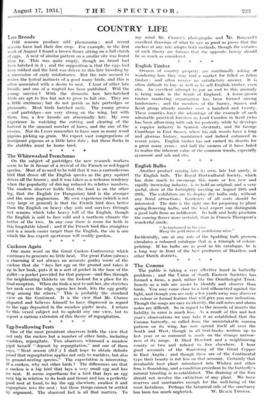COUNTRY LIFE
Late Broods
Odd seasons produce odd . phenomena ; and recent seasons have had their due crop. For example, in the first week of August I found a brown linnet sitting on a full clutch of eggs. A nest of similar pattern on a similar site was found close by. This was quite empty, though no brood had been hatched in it ; and the supposition is that the eggs had been robbed and the bird was driven to this late brooding by a succession of early misfortunes. But the rain seemed to revive the lyrical instincts of a good many birds, and this is often associated with a desire to nest. I hear of other late broods, and one of a wagtail has been published. Will the young survive ? With the domestic hen late-hatched birds are apt to live but not to grow to full size. They are a little cretinous ; but do not perish as late partridges or pheasants. Most birds hatched early. The young grouse —and partridges—are very strong on the wing, but with them, too, a few broods are abnormally late. My own experience in watching the cutting and clearing of the harvest is the unusual number of hares, and the size of the coveys. Nor do I ever remember to have seen so many wood pigeons picking up grain. We expect vast congregations of immigrant pigeons at a little later date ; but these flocks in the stubbles must be home bred.


































 Previous page
Previous page